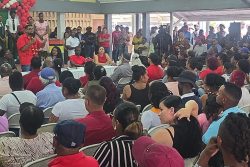The World Series of Major League Baseball (MLB) began last night with the heavily favoured Los Angeles Dodgers opposing the underdog Tampa Bay Rays. When the revised 60-game season was announced in June, the top two high rollers, the New York Yankees (with a payroll of US$113.9M) and the Dodgers (US$105.5M) were listed as joint favourites to win the World Series, whilst the Rays (US$28.6M), 27th on the 30 team payroll list, was listed at 18 – 1 odds to win it all.
When the playoffs began a few weeks ago, the bookmakers posted the Rays, who faced the mighty Yankees in the first round, at 30 – 1. The Rays, not only disposed of the Yankees, but also the much despised Houston Astros, the 2017 World Series Champs, whose legacy has been tainted with the cheating scandal. Despite these performances, the Rays are considered the underdogs against the Dodgers, who had to overcome a 3 – 1 deficit against the Atlanta Braves to advance to the World Series.
Why should we, here in the West Indies, be taking notice of the performance of the Tampa Bay Rays? The Rays, who play in the American League East Division, alongside the Yankees and the Boston Red Sox (fourth highest payroll at US$83.2M), posted the best record in the American League this year, with 40 wins and 20 losses. How does a team with the fourth lowest payroll and listed in the bottom two of the average attendance per game for the last five years, achieve these results? The simple answer is team culture.
The Tampa Bay Rays are the most innovative team in baseball and have developed a team culture which permeates the length and breadth of the organization. The Rays are stuck in Tampa Bay, at least until 2027 when their stadium lease expires. Tampa Bay is a metropolitan centre which attracts a high percentage of retirees, who have no interest in attending baseball games. With no fan base to generate significant revenue (average attendance per game for the past five years hovers in the 15,000 range, whilst the Dodgers, the top draw, average 49,000), the Rays have to be very savvy when it comes to expenditure on salaries.
The Rays have been at the forefront of the information age since owner Stuart Sternberg took control of the franchise in October 2005. The organization has quietly cultivated a culture of better player evaluation and scouting methods. Their undisclosed goal is obviously to lead the competition in every area where their limited working capital is not the determining factor. Their front office was the first to hire a Process and Analytics Coach. Titles adorning other offices include Baseball Science Information and Mental Skills Coach. The roster has been put together with a series of under-the-radar acquisitions, harvesting talent which didn’t appeal to their previous teams, but was also the ‘right fit’ for the organisation. Their main focus in recent times has been hitters (batters) with high exit velocity and pitchers (bowlers) who throw hard.
On the actual field of play, the Tampa Bay Rays lead baseball in re-inventing the game and doffing their hat at age old traditions. Over a decade ago they re-introduced the four man outfield (as opposed to three fielders) and over the past four years, popularized the infield shift, where three, rather than the standard two infielders, were positioned on the hitter’s favoured side. This strategy, which was quickly adopted by other MLB teams, was deployed more often against left-handed hitters, until the Rays started applying it equally effectively against right- handed hitters.
On May19th, 2018, the Rays started a relief pitcher, thus creating the role of the ‘opener.’ Traditionally, games were started by a starting pitcher, a ‘starter,’ who, on the average, pitched five or six innings. The ploy, which is meant to use the ‘starter’ in a different role, allows the pitching team to line up a good reliever against the top of the opposing batting order, which is normally three of the best hitters available (part of the reason why the first inning has normally been the highest scoring). With starting pitchers commanding astronomical salaries on the free agency market, the Rays had found another innovative solution to their limited funds.
Here, in the West Indies, we can reminisce about cricket’s Glory Days of the 1980s and 1990s, and then bleat about the dysfunctional boards and the team being stuck in the doldrums, but it will not change the current situation. However, what we can do is borrow a page from the Tampa Bay Rays and set about changing our entire team culture.
The Skerritt Adminstration will have the responsibility of infusing this ‘new culture’ within our team. Whilst we may not have scouts in cricket as in baseball, we have very experienced and knowledgeable former Test players who are more than willing to work with and mentor the current and upcoming players. These valuable resources should not be wasted.
The challenges will be not be easy for Coach Simmons and the Selection Panel. As a new culture permeates the team, difficult goals must be set with specific timelines. How about the West Indies becoming the best fielding side in the world within the next two years?
The Tampa Bay Rays have shown us that with the right personnel and the right team culture, anything can be achieved.








